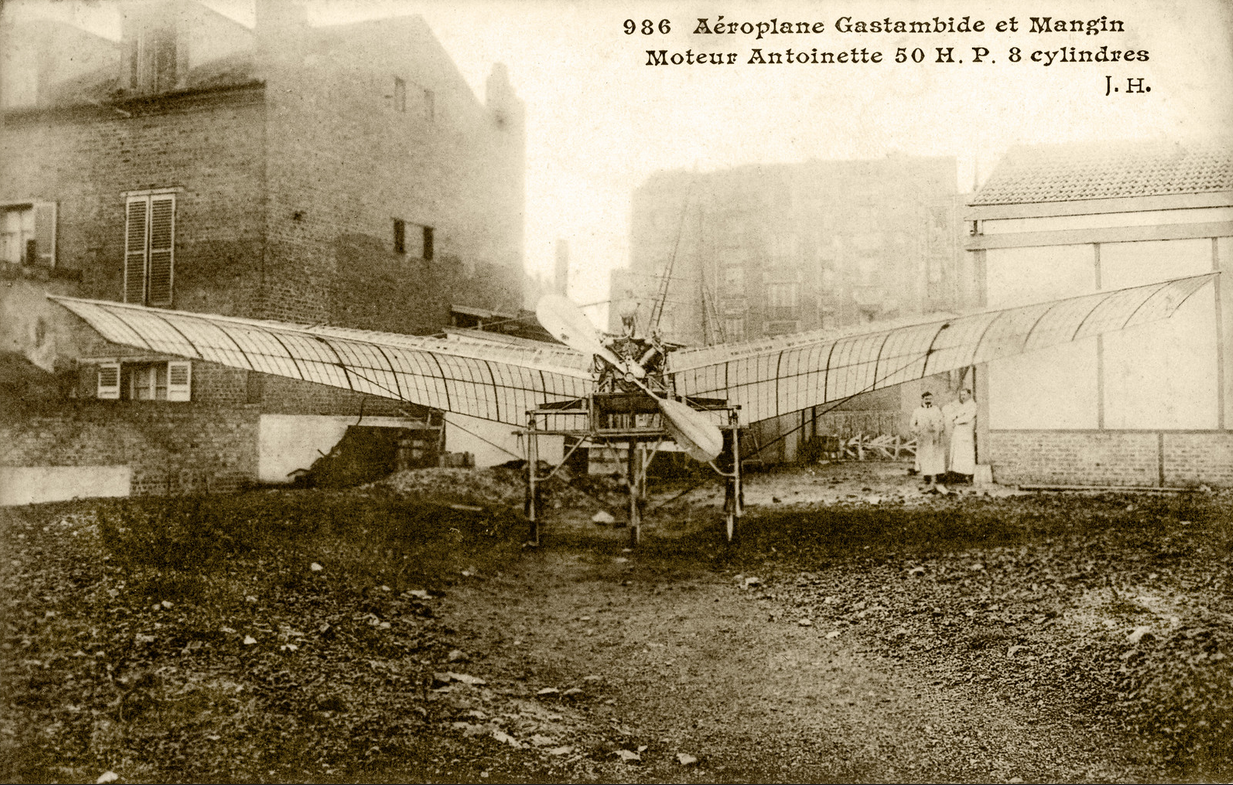
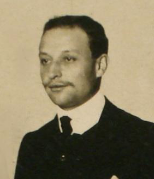
8 February 1908: The Gastambide-Mengin Monoplane made its first flight at Parc de Bagatelle, Paris, France, flown by the company’s mechanic, Louis Boyer. Financed by Jules Adrien Gastambide (1846–1944) and designed by Gabriel Mengin (some sources say it was designed by Léon Levavasseur, who also designed its engine).
The airplane rolled approximately 30 meters before taking of, then climbed to a height of 4–5 meters, covering just a few meters distance before the pilot switched off the ignition and it came down hard. The propeller and landing gear were damaged, but Boyer was not hurt. The fuselage and wings were undamaged. Repairs were made quickly.
This engine, of which the Aerophile of January 1, 1908 published the characteristics and sketches, after some preliminary tests, made its first flight on February 8, in the morning, at the Bagatelle training ground where Santos-Dumont made his unforgettable debut as an aviator.
Under the thrust of its propeller activates a 50 horsepower Antoinette engine, the device, mounted by the mechanic Boyer, after having rolled about thirty meters, took off, rose to 4 to 5 meters in height, crossing a few meters during the flight. But, almost immediately, he reared up; the mechanic cut the ignition and the airplane came back hard to the ground.
The propeller and the undercarriage were false, but the aviator had no harm; the wings and engine were intact. In this experiment, it is important to note the brevity of the momentum necessary for the rise.
Repairs were made quickly. A new wooden carrier frame with two large 2-roller wheels replaced the old steel tube frame. The experiments resumed at Bagatelle on February 12. After a first attempt without taking off, the left wheels left the ground for a moment, the airplane pivoted on its right wing and stopped; but the chassis was dislocated.
The next day, the success was clear. The aircraft took off easily, made a turn in full flight and traveled 100 meters in the morning and 150 meters in the afternoon, in the presence of MM. Gastambide, Mengine, Paul Tissandier, Ernest Zens, Andres Fournier, etc.
Finally, on February 14, the aircraft, which can be described well, made a few small flights to begin, but on returning from Polo to the Puteaux bridge, the airplane flew away over a distance of about 60 meters, climbing to 6 or 7 meters high. At this moment, the pilot, wanting to avoid the clump of trees in the middle of the lawn at Bagatelle, gave a rather sudden jerk of the rudder which caused the aircraft to tilt slightly.
At the same time, he reduced the ignition advance a little too abruptly. The airplane came into contact with the ground fairly quickly, following an inclined plane.
A side wheel having yielded, the front of the aircraft struck the ground, and the aircraft, although having only a low speed, turned over and overturned.
The mechanic Boyer, who mounted him, protected by the wings and the body, had, fortunately, no harm.
The 50 HP Antoinette engine, which powered the aircraft, was completely unharmed, as were the wings and the body.
Only the tail, one wheel and part of the wheel frame were broken. Repairs could be done quickly.
l’Aérophile, 16° Année.—N° 5, 1 Mars 1908, Page 86–87
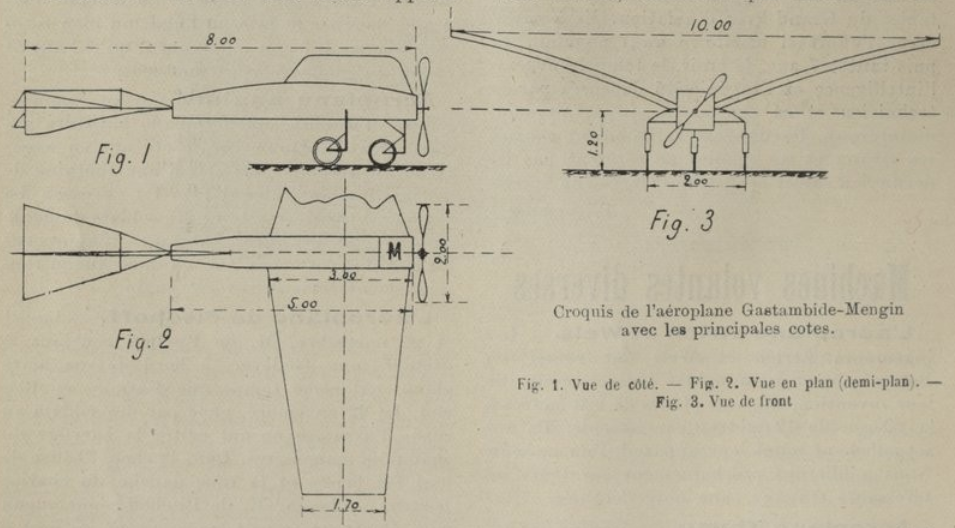
°
THE NEW MONOPLANE OF GASTAMBIDE AND MENGIN.
By M. Mengin
The construction of an aeroplane by M. Robert Gastambide and myself, announced some time ago, has now been completed.
We are partisans with MM. Santos-Dumont and Bleriot in the type of machine, monoplane, and have decided on that type.
The wings have a total spread of 10 meters and are attached to the body by a system of grooves which makes them easily detachable. They are held, on the other hand, to this same body by a new and original system of girders which are made up of thin sheets of steel which offer, in addition to less resistance to the air, greater solidity than those means heretofore employed. The chassis is fitted with wheels having a certain amount of play longitudinally and transversely, designed especially to minimize the shock of landing. The body of the apparatus, which is 5 meters long, carries in front a 50 h.p. 8 cyl. Antoinette motor, with one propeller mounted in front directly on the shaft. In the middle of the “cage” sits the aviator and at the extreme rear there is a tail for stability, serving as the sole means of governing the direction.
After a number of trials with small models we have thought it would be sufficient to give the apparatus an invariable angle of resistance and to rely only on the mobility of the 8 cylinder motor to modify the speed of the machine and, consequently, the form of its trajectory. We have thus abolished totally any governor for raising and lowering.
The total weight of the airplane will not exceed 400 kilograms. Trials of the propeller on the motor, made on the block of special construction, we found that we can easily count on 140 kilograms of thrust and we think we ought to bring the speed up to 55 kilometers per hour.
After a well deserved rest we will begin trials with the apparatus. The apparatus was put on its feet in less than three weeks.
[The screw has a diameter of 2 meters, 1.3 meters pitch. The total surface is 24 square meters.—Ed.]
—Aeronautics: The American Magazine of Aerial Locomotion, Vol. II, No. 2, Page 35
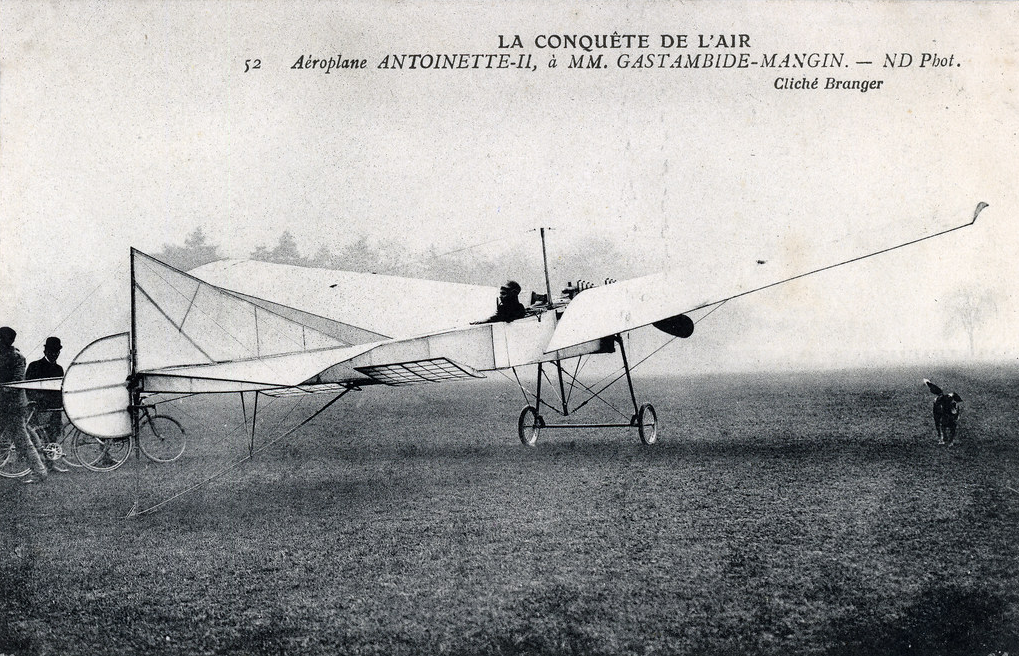
Length 7.90 meters, wing span 10.00 meters, surface area 24.00 meters, mass 350 kg
The Gastambide-Mengin monoplane made its first trial on the 8th. The machine had risen about 5 metres and progressed horizontally about as far when it started to capsize. The driver, Boyer, saw the movement and shut off the power just in time.
On the 12th it was brought out and made short runs in the Bois de Boulogne, The machine seemed to behave very well. At the first trial it made a distance of 60 metres at a height of 6 metres. To avoid a clump of bushes a quick turn was given the rudder and the machine came down. One wheel struck an obstruction and the machine turned over. M. Boyer, the aviator, was uninjured. Considerable damage was done. The general impression concerning the Gastambide aeroplane is that a similar accident will happen regularly as long as the constructors refuse to fit a horizontal rudder or headpiece, whereby height and angle of the machine may be controlled when in the air. With the aeroplane, as it was yesterday, once the ground has been left the only means possessed by the driver to control upward and downward movement is the motor.
—Aeronautics: The American Magazine of Aerial Locomotion, Vol. II, No. 3, Page 27
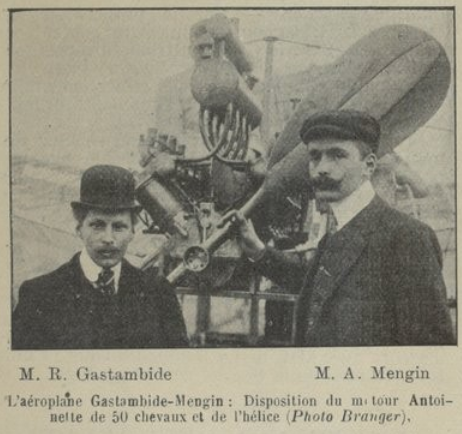
Antoinette V-8, 7,273.6 cc, length 750 mm, width 600 mm, height 600 mm, bore: 15 mm, stroke, 105 mm, weight 60 kg 40/50 h.p. @ 1,400 r.p.m.
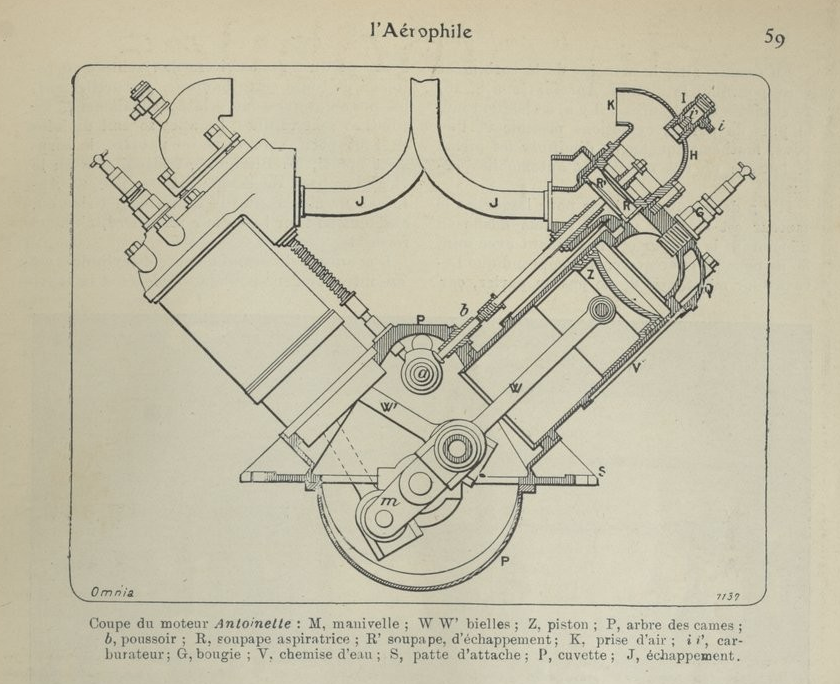
The Gastambide-Mengin Monoplane was powered by a steam-cooled, normally-aspirated, 7.274 liter (443.861 cubic inch displacement) Antoinette 8V 90° overhead valve V-8 engine which produced approximately 45–50 chaval-vapeur (44.4–49.3 horsepower) at 1,400 r.p.m. This engine was considerably smaller and lighter than Levavasseur’s previous V-8s. Because the compression ratio was increased, the aluminum cylinder heads were replaced with forged steel heads. Carburetors were used instead of direct injection, which was prone to clogging. The 8V was a direct-drive engine. The V-8 engine was 0.750 meters (2 feet, 5.5 inches inches) long, 0.600 meters (1 foot, 11.6 inches) wide and (0.600 meters (1 foot, 11.6 inches) high. It weighed 60 kilograms (132 pounds), dry, and 85 kilograms (187 pounds) in running order.
l’aerophile 1 Janvier 1908, pages 12–13:
Two well-known sportsmen, members of the Board of Directors of the "Antoinette" extra-light aviation engine company, MM. Gastambide and Mengin have just joined their efforts to tackle the direct practice of aviation.
They built an airplane of the monoplane type, of which here are the main characteristics: Total wingspan of the wings, from one end, body included: 10 m. 50, these wings having in horizontal projection the shape of a trapezium whose height is 5 m. and the bases respectively of 3 meters on the side of the body and of 1 m. 70 at the opposite end. The body is quadrangular with a length of 5 meters.
The driving part consists of a 50 hp engine. 8 cylinders "Antoinette" of course, which directly drives a propeller 2 meters in diameter and 1 m. 30 paces, seat in front.
The total lifting surface of this airplane is 24 square meters, its weight 350 kg. approximately, including the airman. He therefore took off at a speed of 16 meters per second, or about 55 to 60 kilometres. on time.
The airplane will bear the name Aeroplane Gastambide-Mengin and its first tests will take place soon, probably at Bagatelle to start.
Good luck to the new pioneers of aviation.